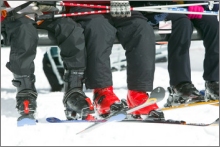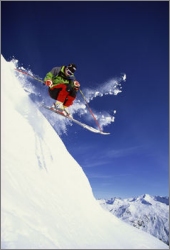Skiing and Snowboarding Injuries on the Rise ... Here's How to Stay Safe While Enjoying These Popular Winter Sports
by www.SixWise.com
Skiing and snowboarding are among the most popular winter sports. In 2007, there were 5.5 million skiers and 5.1 million snowboarders, according to the National Sporting Goods Association (NSGA). Because about 14 percent of snowboarders also ski, and 13 percent of skiers snowboard, that amounts to a total of 9.2 million people hitting the slopes.
|

Over 9 million people enjoyed skiing and snowboarding in 2007.
|
Careening down a slippery, snow-covered mountain, sometimes at speeds as fast as cars, with nothing but a few extra layers of fleece to protect you is an adrenaline rush that hooks countless winter sports enthusiasts ... but it can also be very dangerous.
In fact, ski and snowboard safety advocates recently called into question the safety at California ski resorts, saying that "crowded ski slopes, new ski technologies and limited traffic management contribute to unsafe conditions." The high speeds that skiers and snowboarders reach was also mentioned as a safety concern.
The California Ski and Snowboard Safety Organization (CSSSO) points out that the "basic tenet of ski law is that injuries and death are just an 'inherent risk of the sport,' shielding ski resorts from liability associated with ski and snowboard deaths and injuries regardless of fault."
As a result, they say, "there is no accountability and no accurate or reliable data to objectively guide the public, as well as policymakers, on snow sport risks."
How Common are Skiing and Snowboarding Injuries?
About 40 people die each year while skiing or snowboarding, according to the National Ski Areas Association (NSAA). During the 2007-2008 season in particular, 53 people died out of the 60.5 million average. Of the fatalities, 44 were skiers and nine were snowboarders.
As for serious injuries, which include paraplegics, serious head and other injuries, they occur at a rate of nearly 44 per year, NSAA says. In the 2007-2008 season, there were 41 serious injuries, 32 among skiers and nine among snowboarders.
Ski and snowboard advocates point out that while there is a risk from the sport, it is not any greater than the risk from other high-energy participation sports. When taken in perspective, the rate of fatality for skiers and snowboarders is .88 per million, while the rate of serious injury is .68 per million, NSAA points out.
|

Most fatalities among skiers and snowboarders occur among males in their late teens to late 30s.
|
Further, they suggest that other common sports may be even more dangerous. For instance, there were 3,800 fatalities linked to swimming in 2006, and 1,100 fatalities linked to bicycling that same year, for a total of 73 fatalities per million participants for swimming, and 29 fatalities per million for bicycling.
Protecting Yourself While Enjoying Winter Sports
"Most fatalities occur in the same population that engages in high-risk behavior," according to Dr. Jasper Shealy, a professor at Rochester Institute of Technology who has studied ski-related injuries for more than 30 years.
As he reports on CSSSO's Web page:
-
Victims are predominantly male (85 percent) and from their late teens to late 30s (70 percent)
-
Less than 10 percent of fatally injured skiers and snowboarders are under 10 or over 50 years of age
-
Most of those fatally injured are usually above-average skiers and snowboarders who are going at high rates of speed on the margins of intermediate trails
Further, a study published in Injury Prevention found that high speeds and more jumps and acrobatics are leading to an increase in serious head and spinal injuries in skiers and snowboarders. The study found that traumatic brain injury rose from 12 percent to 15 percent among skiers and from 1,000 to 5,200 per year among snowboarders from 1992 to 1997.
A separate study found that spinal cord injury rose 130 percent among children and 407 percent among adolescents over the 21-year period from 1972-73 to 1993-94.
In Injury Prevention, the researchers concluded, "There should be enhanced promotion of injury prevention that includes the use of helmets and emphasizes the skier's and snowboarder's responsibility code."
One of the first things you should do as a skier or snowboarder is to know and follow this Responsibility Code, which is endorsed by NSAA:
-
Always stay in control.
-
People ahead of you have the right of way.
-
Stop in a safe place for you and others.
-
Whenever starting downhill or merging, look uphill and yield.
-
Use devices to help prevent runaway equipment.
-
Observe signs and warnings, and keep off closed trails.
-
Know how to use the lifts safely.
NSAA also offers these additional safety and education tips to follow while you're on the slopes:
-
Take a lesson. Like anything, you'll improve the most when you receive some guidance. The best way to become a good skier or snowboarder is to take a lesson from a qualified instructor.
-
The key to successful skiing/snowboarding is control. To have it, you must be aware of your technique, the terrain and the skiers/snowboarders around you. Be aware of the snow conditions and how they can change. As conditions turn firm, the skiing gets hard and fast. Begin a run slowly.
-
Skiing and snowboarding require a mental and physical presence.
-
If you find yourself on a slope that exceeds your ability level, always leave your skis/snowboard on and side step down the slope.
-
The all-important warm-up run prepares you mentally and physically for the day ahead.
-
Drink plenty of water. Be careful not to become dehydrated.
-
Curb alcohol consumption. Skiing and snowboarding do not mix well with alcohol or drugs.
-
Know your limits. Learn to ski and snowboard smoothly -- and in control. Stop before you become fatigued and, most of all have fun.
-
If you're tired, stop skiing. In this day and age of multi-passenger gondolas and high-speed chairlifts, you can get a lot more time on the slopes compared to the days of the past when guests were limited to fixed grip chairlifts.
Recommended Reading
What NOT to do for Cold Hands and Seven Other Winter Tips
The 7 Most Dangerous Youth Sports in America
Sources
National Ski Areas Association
MarketWatch.com November 12, 2008
Injury Prevention 2007;13:368-375
MedPage Today December 4, 2007
California Ski & Snowboard Safety Organization
National Ski Areas Association